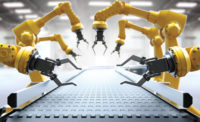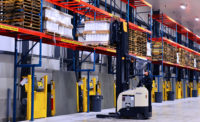The logistics industry is always looking for better, faster and safer ways to manage products and their distribution. That’s why it’s essential for logistics providers to leverage innovative technologies and business processes to keep pace with the exploding growth in online sales and the increased demands for just-in-time products. Compile these challenges with operating temperatures, expiration constraints and product safety, and there’s even more added pressure for today’s food processors.
To combat these complex issues, automation and robotics can enhance the processing line, from packaging to palletizing to delivery. Here's what food chain leaders can expect, and how they can prepare for the future.
The current state of robotics in food logistics
Robotics are advancing the food logistics industry, allowing more and more organizations to implement and streamline their supply chain.
For instance, robotics helps reduce highly repetitive tasks such as moving product from point A to point B or sticking labels onto cans, thus easing the burden of roles regularly affected by turnover. Whereas employees might get bored doing the same tedious task over and over, day after day, robotics can be brought into a potentially unpleasant environment that could drive employees away, and perform this repetitive work.
The future of robotics and automation
When it comes to robotics in the supply chain, history has consistently delivered periodic hype-cycles where advances in both technology and innovation were sure to eliminate massive numbers of jobs. And, current advances in supply chain automation are certainly affecting the workforce as we know it today.
For example, automation is impacting food recalls, where higher accuracy in track-and-trace will more quickly identify potential problems. Robotics and automation involved with the contact of food handling is also safer, as human interaction carries a higher rate of error and chance of contamination. And, with the ability for automation and robotics to work consistently, quickly and around the clock inside freezers and cleanrooms, operations will surely improve efficiency in the food supply chain.
Other areas within the food chain where robotics and automation are on its way to becoming commonplace include the automated palletizing of mixed cases, high-density storage (often resulting in a reduction of coolant loss), automated storage and retrieval system (AS/RS) savings for lights-out operations and more. For food supply chain managers specifically, packaging robotics that utilize machine learning and vision recognition are especially important to pay attention to, as these robots can more efficiently pack frozen items without the needed protection that humans require.
And, the influx of e-commerce sheds light on the more labor-intensive functionality behind picking, as many picking operations are still not automated. Introducing robotics and automation could reduce the labor costs of fulfilling online orders and enables companies to provide 24-hour delivery (or less).
Embrace robotics, or get left behind
While industry experts predict advances in robotics will have significant impact on today’s workforce, it’s important to remember a few things.
For starters, it’s becoming more difficult for third-party logistics providers to find labor in an industry that is growing at record rates. Previous waves of warehouse automation haven’t led to sudden mass layoffs simply because order volumes continue to grow. Implementing robotics and automation requires larger numbers of highly skilled workers to install, configure and maintain this level of automation, thus not eliminating jobs, but in many cases, increasing jobs.
It’s also important to embrace the next generation of robotics and automation, as it’s critical for food supply chain leaders to remain on the forefront of innovation. With robotics, organizations in food logistics can transform their existing processes into more efficient operations with a new type of worker that is highly skilled, less likely to experience turnover, works in a safer environment (while adhering to food safety and storage regulations), and more importantly, enjoys their work.



